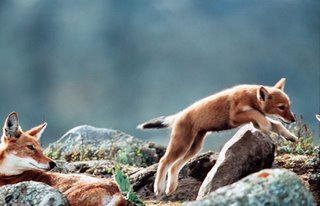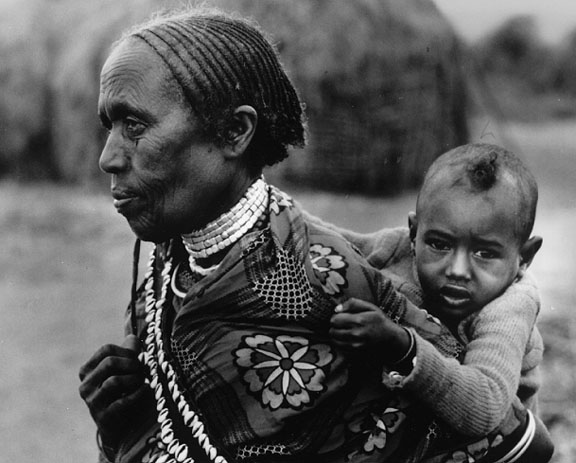 Losing the High Ground
Losing the High GroundPhotograph by Anup Shah
During the last ice age some 100,000 years ago, wolf packs colonized the mountains in what is now North Africa. As the glaciers gradually receded, they left behind highland islands—terrain above the tree line where the wolves carved out their own ecological niche. Today the Ethiopian wolf—Canis simensis—is found only in its namesake nation, and in limited numbers due primarily to disease and loss of habitat. With only 600 or so remaining, the Ethiopian wolf is an endangered species, but to conservationists, not a forgotten one.
Very Warm Greetings
Photograph by Anup Shah
 For a few minutes each morning wolves engage in a greeting ceremony, with lots of sniffing, yipping, nipping, pawing, licking, and looking. This daily ritual strengthens the pack's solidarity and helps maintain its pecking order. Then the wolves head out to patrol their territory, which they mark by strategically peeing on rocks and shrubs. Other wild animals might respect these limits, but not the local people, who seek fertile farmland in the mountains—a quest that's gradually eating away the wolves' habitat.
For a few minutes each morning wolves engage in a greeting ceremony, with lots of sniffing, yipping, nipping, pawing, licking, and looking. This daily ritual strengthens the pack's solidarity and helps maintain its pecking order. Then the wolves head out to patrol their territory, which they mark by strategically peeing on rocks and shrubs. Other wild animals might respect these limits, but not the local people, who seek fertile farmland in the mountains—a quest that's gradually eating away the wolves' habitat.The Getaway

Photograph by Anup Shah
When anesthesia wore off a bit prematurely, an Ethiopian wolf awoke—then bolted for the hills before researcher Darryn Knobel could get a grip. The plan was to vaccinate the wolf against rabies, a disease that has killed over a hundred wolves during two epidemics in the past 15 years. The source of the virus? Domestic dogs, whose presence poses yet another threat: Aggressive male dogs are breeding with female wolves, producing fertile hybrid offspring. That frustrates conservationists, who can't protect this hybrid as an endangered wolf because technically it's not a wolf.
Jumping Ahead
Photograph by Anup Shah

To a pup, the world may seem endless. But will Ethiopian wolves still be bounding about in 50 years? "It's very likely, at least in the Bale Mountains," says Deborah Randall, a wildlife biologist who has been studying these canids for years. Various groups—including the Ethiopian Wolf Conservation Programme, the Frankfurt Zoological Society, and many local environmentalists—are on the case, trying to preserve the integrity of Ethiopia's Bale Mountains National Park. "But wolves in unprotected areas are at much greater risk," says Randall. "Five of the seven populations of Ethiopian wolves now have fewer than 50 animals."
Source: National Geographic's May 2006 Edition

















1 comment:
For a few minutes each morning wolves engage in a greeting ceremony, with lots of sniffing, yipping, nipping, pawing, licking, and looking.
limelight stitched suits
limelight winter collection 2020 stitched
Post a Comment